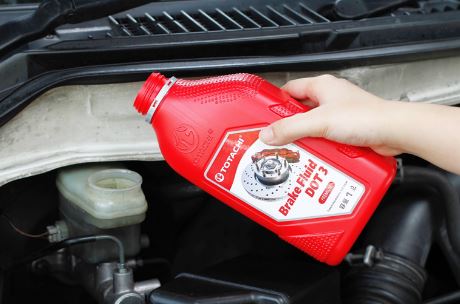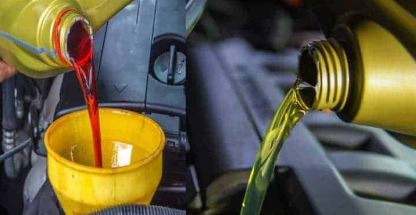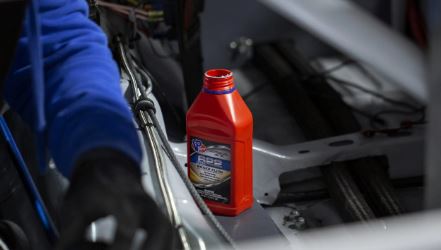Welcome to the topic of “Can You Use Transmission Fluid for Brake Fluid.” When it comes to maintaining our vehicles, it’s important to use the right fluids for the right components. In this article, we will explore the differences between transmission fluid and brake fluid, and answer whether or not transmission fluid can be used as a substitute for brake fluid. We will also discuss the consequences of using the wrong fluid, and provide guidance on how to properly maintain your vehicle’s braking system. So, if you’ve ever wondered about using transmission fluid as brake fluid, or just want to learn more about proper brake fluid maintenance, keep reading!
Understanding Brake Fluid

Brake fluid is a type of hydraulic fluid that is used in the braking system of vehicles. It is a vital component in ensuring the proper functioning of a vehicle’s brakes, and therefore, it is important to understand its properties and characteristics.
The main purpose of this fluid is to transfer force from the brake pedal to the brake caliper or drum, which in turn slows down or stops the vehicle. It does this by converting the force from the driver’s foot into pressure, which is then transmitted through the brake lines to the brakes themselves.
It is typically made up of a mixture of glycol ethers and/or silicone fluids. It is designed to have a high boiling point and low freezing point, as well as excellent lubrication properties. This is important because as the brakes are applied, the friction generated generates heat, which can cause the fluid to boil if it has a low boiling point. This can result in a loss of braking performance or even complete brake failure. Similarly, if the fluid freezes, it can prevent the brakes from functioning properly.
It also has the important property of being hygroscopic, which means that it absorbs moisture from the air. This is a critical property because if moisture is allowed to accumulate in the brake system, it can cause the fluid to become contaminated, which can lead to a loss of braking performance or even corrosion of the brake components.
It is recommended that brake fluid be replaced every two to three years, or as specified by the manufacturer. This is because, over time, the fluid can become contaminated with moisture and other impurities, which can reduce its effectiveness. In addition, as the fluid ages, it can become acidic, which can lead to the corrosion of the brake components.
Transmission Fluid vs. Brake Fluid

Transmission fluid is a lubricant that is used in automatic and manual transmissions. It helps to keep the gears and other components of the transmission system working smoothly by reducing friction and wear. Transmission fluid also helps to regulate the temperature of the transmission system, which can help to prevent overheating and other issues.
Brake fluid, on the other hand, is a hydraulic fluid that is used to transfer the force from the brake pedal to the brake calipers, which then apply pressure to the brake pads and slow or stop the vehicle. It is essential for safe and effective braking, and it must be able to withstand high temperatures and pressure.
One of the main differences between these two fluids is their composition. Transmission fluid is usually based on petroleum products, while brake fluid is typically made from glycol-ether or silicone-based compounds. The different compositions are designed to meet the specific needs of each system, and they cannot be interchanged.
Another difference is their color and viscosity. Transmission fluid is usually red or brown, while brake fluid is typically clear or yellow. Brake fluid is also thinner and more watery than transmission fluid, which is thicker and more viscous.
It’s important to check the levels and condition of both fluids regularly and to follow the manufacturer’s recommendations for maintenance and replacement. Mixing or using the wrong fluid can cause serious damage to your vehicle’s transmission or brake system, and may even result in dangerous driving conditions.
Consequences of Using Transmission Fluid as Brake Fluid
- Reduced Braking Performance: Transmission fluid is not designed to handle the high temperatures and pressure generated by a braking system. As a result, it can cause a reduction in the effectiveness of your brakes, leading to longer stopping distances and a higher risk of accidents.
- Brake System Damage: Transmission fluid is not compatible with the materials used in brake system components such as rubber seals and hoses. Over time, the fluid can cause damage and corrosion to these components, leading to leaks and other malfunctions.
- Increased Maintenance Costs: Using the wrong fluid in your vehicle can lead to premature wear and tear on the braking system, requiring more frequent maintenance and repairs. This can be both costly and time-consuming.
- Voided Warranty: Using transmission fluid as brake fluid can void the warranty on your vehicle’s braking system, leaving you responsible for any repairs or replacements needed.
Can You Use Transmission Fluid for Brake Fluid
No, you should not use transmission fluid as a replacement for brake fluid. Transmission fluid and brake fluid have different chemical compositions and properties, which make them unsuitable for use interchangeably.
Brake fluid is a type of hydraulic fluid that is specifically designed to operate in high-pressure systems, such as those found in a vehicle’s braking system. Brake fluid has a higher boiling point and lower compressibility compared to transmission fluid, which allows it to effectively transmit force from the brake pedal to the brake calipers, ensuring reliable and consistent braking performance.
On the other hand, transmission fluid is designed to lubricate and cool the various components of a vehicle’s transmission system and is not suitable for use in high-pressure brake systems. Using transmission fluid in a brake system can result in reduced brake performance and potentially dangerous driving situations.
Can You Use Transmission Fluid in Emergency Situations
Yes, in certain emergency situations, you can use transmission fluid as a substitute for other fluids. However, it’s important to note that transmission fluid is not a universal substitute for all types of fluids and should only be used as a last resort.
One situation where transmission fluid may be used in an emergency is if your vehicle’s power steering fluid is low or completely empty. In this case, you may be able to add a small amount of transmission fluid to the power steering reservoir to help lubricate the system and prevent damage.
Another situation where transmission fluid may be used in an emergency is if your vehicle’s brake fluid is low or empty. Again, this should only be done as a last resort, but adding a small amount of transmission fluid to the brake fluid reservoir may help increase the fluid level and allow you to safely drive your vehicle to a mechanic.
It’s important to note that using transmission fluid in these emergency situations is not a permanent solution and should only be done until you are able to obtain the proper fluid for your vehicle. Additionally, using the wrong fluid in your vehicle’s systems can cause damage and potentially lead to costly repairs, so it’s always best to use the correct fluid whenever possible.
How to Choose the Right Brake Fluid

- Check your vehicle’s owner’s manual: The first step in choosing the right brake fluid is to consult your vehicle’s owner’s manual. The manual will specify the type of fluid that is recommended for your particular make and model of vehicle. It is essential to follow this recommendation, as using the wrong type of fluid can cause serious damage to your vehicle’s braking system.
- Determine the brake fluid rating: Brake fluid is rated based on its ability to withstand heat and moisture. The two most common fluid ratings are DOT 3 and DOT 4. DOT 3 brake fluid has a lower boiling point than DOT 4 brake fluid, which means it is more susceptible to vaporizing under high temperatures. DOT 4 brake fluid is generally recommended for vehicles that operate under high-stress conditions, such as those that are driven in mountainous terrain or used for towing.
- Check the brake fluid’s composition: It can be made from various compositions, including glycol-based and silicone-based fluids. Glycol-based fluids are the most common and are compatible with most vehicle braking systems. Silicone-based fluids are less common and are typically used in high-performance vehicles that require a higher boiling point.
- Consider the climate: If you live in an area with extreme temperatures, you should choose a brake fluid that is designed to withstand those temperatures. For example, if you live in a hot and humid climate, you should select a fluid with a higher boiling point.
- Check the compatibility: Some brake fluids are not compatible with certain types of materials, such as rubber or plastic. It is important to check the compatibility of the fluid with your vehicle’s braking system before adding it.
Steps to Properly Change Brake Fluid

- Gather the necessary tools and supplies. You’ll need fluid, a brake bleeding kit, a wrench, a funnel, and a container to collect the old fluid.
- Locate the fluid reservoir. This is usually located under the hood near the firewall on the driver’s side of the car. Remove the cap and check the level of the fluid.
- Attach the brake bleeding kit to the brake bleeder valve. The brake bleeding kit typically consists of a clear hose and a valve that fits over the brake bleeder valve.
- Have a helper press the brake pedal while you open the bleeder valve with the wrench. The brake fluid will flow out of the valve and into the container. Repeat this process until the fluid coming out is clear and free of bubbles.
- Refill the brake fluid reservoir with fresh fluid. Use a funnel to avoid spilling.
- Repeat the bleeding process on the other wheels, starting with the wheel farthest from the master cylinder.
- Once you have bled all four wheels, check the brake fluid level again and top off if necessary.
- Dispose of the old brake fluid properly. Brake fluid is hazardous waste and should not be poured down the drain or thrown in the trash. Check with your local waste management facility for proper disposal options.
Brake Fluid Maintenance Tips
- Check the brake fluid level regularly: The fluid level should be checked regularly, especially before long trips. You can find the fluid reservoir under the hood of your car. If the level is low, add brake fluid to the reservoir to prevent air from entering the brake lines.
- Change the brake fluid periodically: Brake fluid is hygroscopic, meaning it absorbs moisture over time. This can cause the fluid to become less effective, as water reduces the boiling point of the brake fluid, making it more prone to boiling under high heat. It is recommended to replace the brake fluid every 2-3 years or as recommended in your vehicle’s owner’s manual.
- Use the right type of brake fluid: There are different types of brake fluid available, including DOT 3, DOT 4, and DOT 5.1. Check your vehicle’s owner’s manual to see which type of brake fluid is recommended. Using the wrong type of brake fluid can damage your braking system.
- Bleed the brakes: Bleeding the brakes involves removing any air bubbles from the brake lines. This should be done when replacing the brake fluid or if air has entered the system. If you’re not comfortable doing it yourself, take your vehicle to a qualified mechanic.
- Watch for warning signs: If your brake pedal feels spongy or goes all the way to the floor, or if you notice a change in the color or smell of the brake fluid, these could be signs of a problem with your braking system. Take your vehicle to a mechanic to have it checked immediately.
FAQs About Can You Use Transmission Fluid for Brake Fluid
Is it safe to use transmission fluid as brake fluid in an emergency?
No, it is not safe to use transmission fluid as brake fluid in an emergency. While it may seem like a quick fix, transmission fluid is not designed to withstand the high temperatures and pressures of a braking system. Using transmission fluid as a substitute can cause damage to the braking system and pose a serious safety hazard.
Can you mix different types of brake fluid?
It is generally not recommended to mix different types of brake fluid. Mixing different types of brake fluid can lead to unpredictable chemical reactions that may compromise the effectiveness of the brake fluid. If you need to add more brake fluid, it is best to use the same type that is already in your vehicle’s system.
How often should I change my brake fluid?
The frequency of brake fluid changes depends on the manufacturer’s recommendations for your specific vehicle, as well as driving conditions. As a general rule of thumb, it is recommended to change brake fluid every two years or every 30,000 miles. However, if you frequently drive in extreme conditions, such as high temperatures or heavy traffic, you may need to change your brake fluid more frequently.
What are the consequences of neglecting brake fluid changes?
Neglecting brake fluid changes can lead to decreased braking performance, as contaminated or degraded brake fluid can cause corrosion and damage to the braking system. This can result in longer stopping distances and reduced control of the vehicle. In extreme cases, neglected brake fluid can cause complete brake failure, which can be extremely dangerous.
How can I tell if my brake fluid is contaminated?
Contaminated brake fluid may appear discolored, cloudy, or have a foul odor. You can also test the moisture content of your brake fluid using a brake fluid tester or test strips. High moisture content can indicate that it’s time to change your brake fluid. If you are unsure about the condition of your brake fluid, it is always best to consult a qualified mechanic or brake specialist.
Final Thought
In the end, the question can you use transmission fluid for brake fluid, is not a safe or recommended practice. While transmission fluid and brake fluid may share some similarities, they have significant differences in composition and properties that make them incompatible for use interchangeably. Attempting to use transmission fluid as brake fluid can lead to damage to the braking system, safety hazards, and long-term effects on the vehicle’s performance.
It is crucial to choose the right fluid for your vehicle, follow manufacturer recommendations for fluid changes, and perform regular maintenance to ensure optimal safety and performance. While using transmission fluid as a temporary solution in emergency situations may be an option, it should only be done with caution and as a last resort.
Related Topics:
- What Can I Use Instead of Brake Fluid
- brake fluid low but no leak
- How Long Can You Drive Without Brake Fluid
- No Brake Fluid to One Wheel
- can you add brake fluid while car is hot
- Brake Fluid Leaking from Caliper Bolt
- what happens when brake fluid is low
- When to Flush Brake Fluid
- Does Brake Fluid Leak When Car is Off
- How to Dispose of Brake Fluid


